Resignation letter via email template
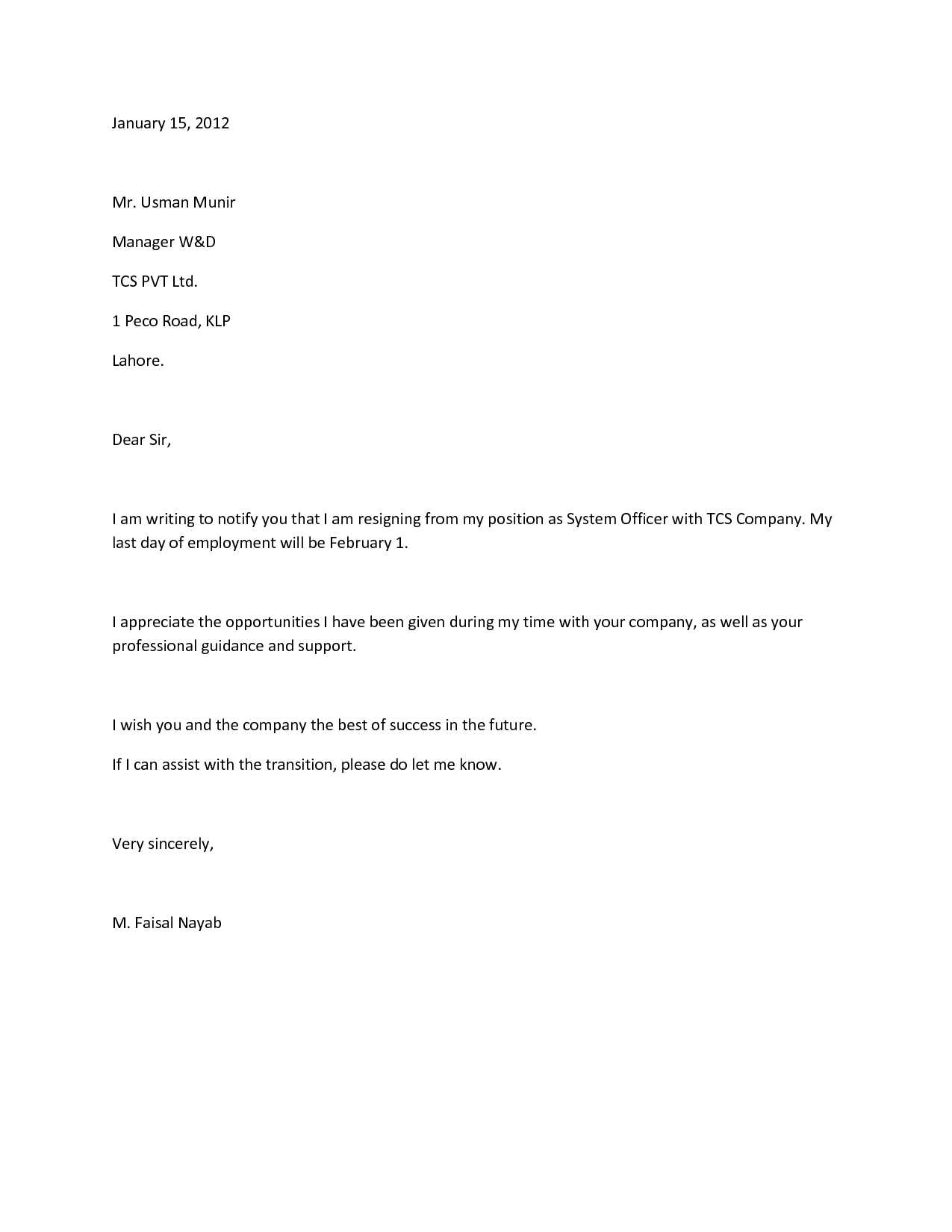
Before sending your resignation email, ensure that your message is concise and professional. A well-structured resignation letter can maintain a positive relationship with your current employer and preserve your reputation for future opportunities. This template will guide you through the key elements that should be included in your resignation email.
Start with a clear and direct statement of your decision to resign. Mention your intended last working day and avoid unnecessary details. Keep the tone respectful and appreciative, acknowledging the opportunity you had at the company. Be sure to provide adequate notice, as outlined in your contract or company policy.
For a smooth transition, offer your assistance in the handover process. This could involve helping with training a replacement or completing important projects before your departure. It shows professionalism and leaves a positive impression as you exit the company.
End your email by expressing your thanks again, leaving the door open for future contact. Keep the closing simple and positive, avoiding any negativity. A well-crafted resignation email not only demonstrates respect but also leaves the relationship intact for the future.
Here’s the revised version:
Keep the tone respectful and straightforward. Begin with a clear subject line to ensure the recipient knows the email’s purpose right away. Use a polite opening, such as “Dear [Manager’s Name],” and proceed with a concise explanation of your decision to resign, including the effective date. Stay positive about your time at the company, but avoid overly personal details. Acknowledge your gratitude for the opportunities you’ve had and offer assistance during the transition. Close the letter with a professional sign-off like “Sincerely,” followed by your name.
Ensure the email is free from any spelling or grammatical errors before sending. Double-check that the message is clear and the tone is professional, leaving a good impression for future references.
- Resignation Letter via Email Template
Begin your resignation email with a clear and professional subject line. This helps set the tone right away. For example, “Resignation Notice – [Your Name].” It’s direct and lets your employer know the purpose of the message immediately.
Subject Line
Subject: Resignation Notice – [Your Name]
Email Body
Start your email with a polite greeting. Address the recipient by name, preferably your manager or supervisor.
In the opening sentence, clearly state your intention to resign and specify the date your resignation becomes effective. A straightforward approach shows respect for the reader’s time and avoids unnecessary ambiguity. For example: “I am writing to formally resign from my position as [Your Job Title], effective [Date].”
Express gratitude for the opportunity to work with the company, even if your departure is due to personal reasons. Keep the tone appreciative and positive, such as: “I want to thank you and the team for the opportunity to contribute to the company and for the support provided during my time here.”
If possible, offer to help with the transition. This can include training a replacement or completing current projects. A sentence like: “I’m happy to assist in making the transition as smooth as possible,” can demonstrate your professionalism.
Close with a polite sign-off. “Sincerely” or “Best regards” are standard, followed by your full name and contact information, if needed.
Here’s an example of a full resignation email:
Subject: Resignation Notice – [Your Name]
Dear [Manager’s Name],
I am writing to formally resign from my position as [Your Job Title], effective [Date]. I have greatly enjoyed my time working with the company, and I appreciate the support and opportunities provided to me during my tenure.
I am happy to assist with the transition in any way I can to ensure a smooth handover of my responsibilities. Please let me know how I can be of help during this time.
Thank you again for the opportunity to be part of the team. I look forward to staying in touch, and I wish the company continued success.
Sincerely,
[Your Name]
Begin your resignation email by stating your intention to resign clearly. Use a straightforward approach to avoid any ambiguity.
- Start with a formal greeting, using the recipient’s name or title. If you don’t know the person well, address them with their professional title.
- In the opening sentence, mention your position and the company you’re resigning from. For example: “I am writing to formally resign from my position as [Your Position] at [Company Name].”
- Clearly specify the date of your resignation, ideally adhering to the company’s notice period. For instance: “My last working day will be [Date], in accordance with my notice period.”
Keep the tone respectful and avoid unnecessary explanations. This directness will help the email appear professional and clear from the start.
Include your resignation date clearly in the first paragraph. Specify the exact day you plan to leave. A two-week notice is standard, but this might vary depending on your contract or company’s policy. Providing a specific end date ensures clarity for both you and your employer.
1. State the Position You’re Resigning From
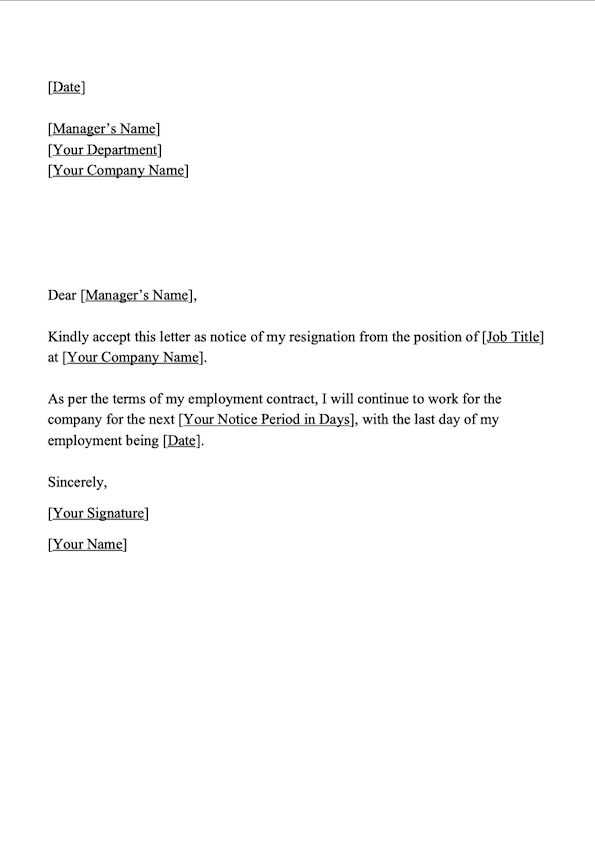
Clearly mention your job title and the department you worked in. This helps avoid any confusion, especially in larger organizations where multiple employees may hold similar roles.
2. Express Gratitude
While resigning may be due to personal reasons or new opportunities, it’s important to acknowledge any positive experiences or growth you’ve had in the company. A short thank you note can leave a good impression.
- Acknowledge mentorship, opportunities for growth, or experiences that shaped your career.
- Keep the tone positive and professional to maintain a good relationship with your employer.
3. Offer Assistance with Transition
Offer help with the transition process. This could mean training a replacement or helping to wrap up current projects. This gesture demonstrates professionalism and helps leave a lasting positive impression.
4. Include Contact Information
Provide your personal contact details in case your employer needs to reach you after you leave. This could be important for follow-up on post-resignation matters, such as benefits or final pay.
5. Keep It Concise
Your resignation letter doesn’t need to be long. Stick to the key points and avoid unnecessary details about your reasons for leaving. Keep the tone respectful and to the point.
Best Practices for Choosing the Right Tone in Your Resignation Email
Maintain a respectful and professional tone, even if you’re leaving due to negative reasons. A neutral, positive attitude shows maturity and ensures you leave the door open for future opportunities. Avoid being overly casual or emotional, as this could reflect poorly on your character and judgment.
Be Polite and Grateful
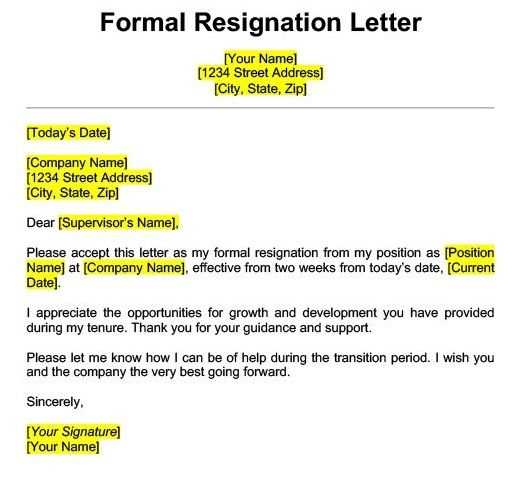
Express appreciation for the opportunities you’ve had. A simple “thank you for the chance to work here” can go a long way in leaving a positive impression. Acknowledging the support from colleagues and managers shows professionalism and helps preserve relationships for the future.
Stay Concise and Clear
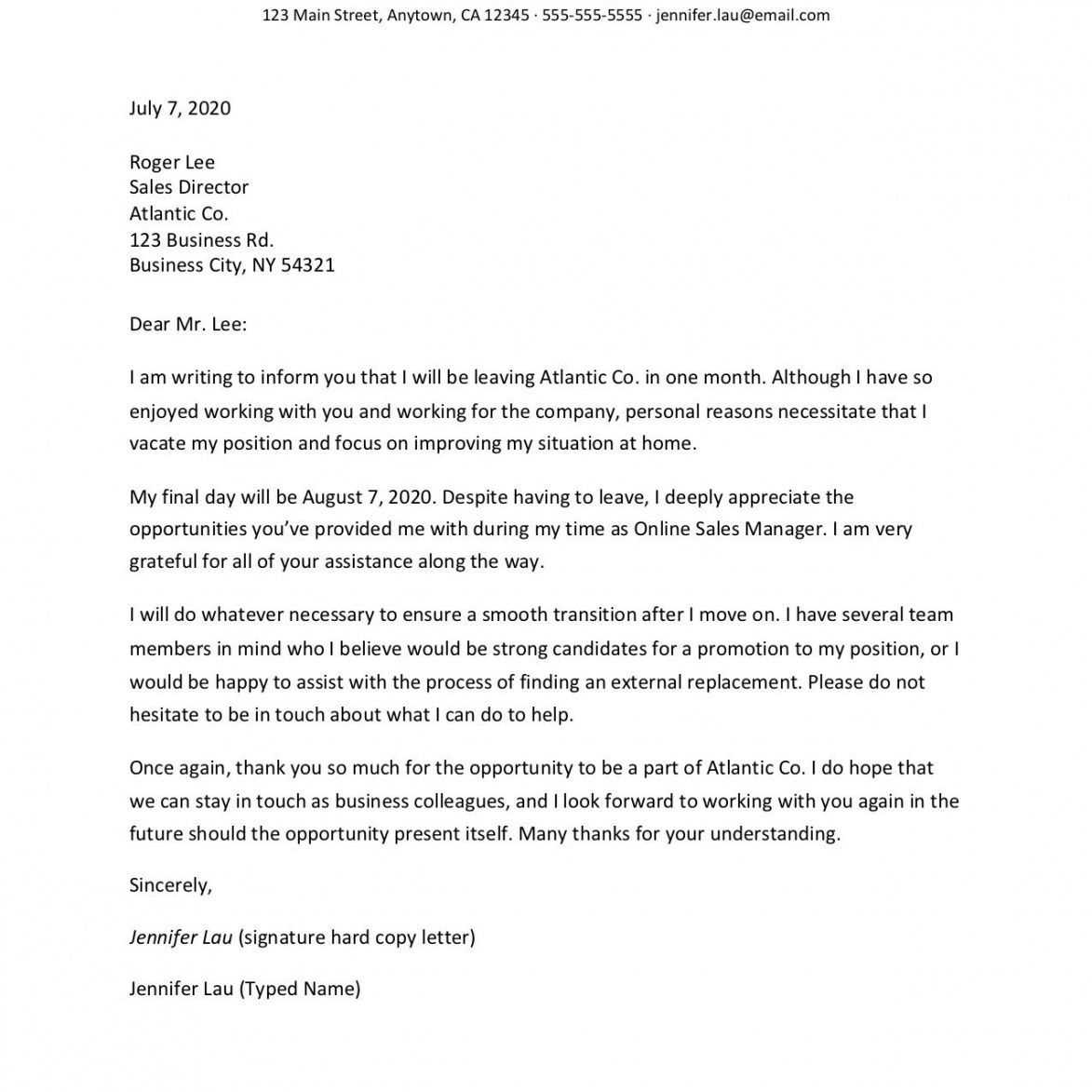
Keep your email brief, focusing on your resignation and next steps. Avoid providing excessive detail about your reasons for leaving. If necessary, mention that you’re happy to discuss in person or during an exit interview. Avoid negative comments or criticism about the company or colleagues in your email.
How to Address the Recipient in a Resignation Letter
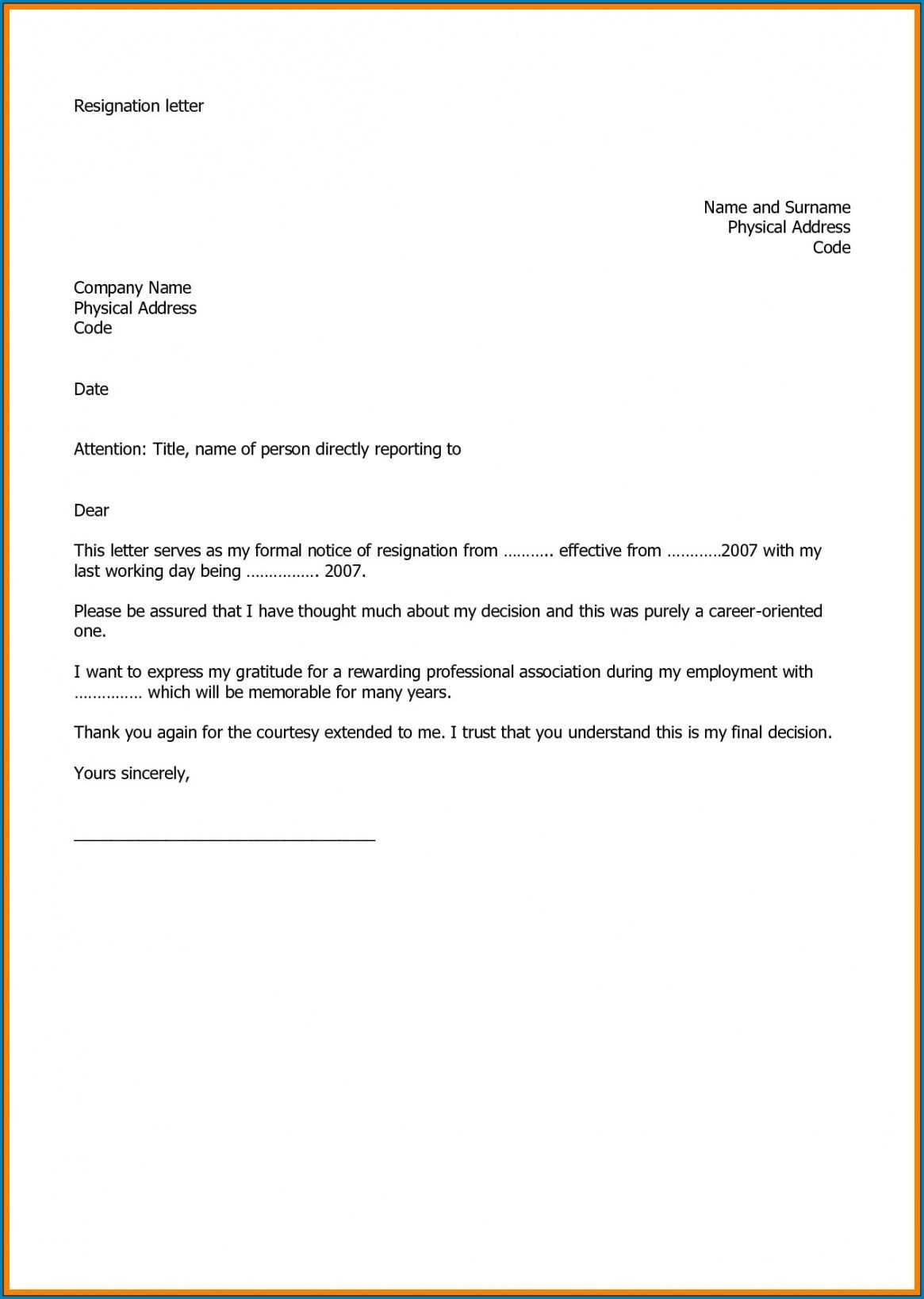
Start by addressing your letter directly to your immediate supervisor or manager. Use their formal title, such as “Dear Mr. Smith” or “Dear Ms. Johnson.” If you have a close working relationship with your boss, you can consider using their first name, but it’s best to err on the side of professionalism.
In cases where you’re unsure of the appropriate salutation, a neutral “Dear [Job Title]” works well, for example, “Dear Hiring Manager” or “Dear Human Resources Director.” Keep the tone respectful and formal, avoiding overly casual greetings like “Hey” or “Hi.” This sets a professional tone from the outset.
When resigning via email, it’s also a good idea to include the subject line clearly stating your intention, such as “Resignation Notice – [Your Full Name].” This allows the recipient to immediately understand the purpose of your communication.
Clearly state your notice period in the resignation email. Specify the exact dates you will be available to work and your intended last day. This helps your employer plan for a smooth transition and sets expectations on both sides.
It’s also beneficial to express your willingness to assist with the handover process. Offer to train a colleague or document important tasks and responsibilities. This shows professionalism and strengthens your reputation, leaving a positive impression as you exit.
Keep the tone respectful and accommodating while being firm about your availability. Avoid vague statements like “I’ll stay until you find a replacement.” Instead, mention your specific last working day and acknowledge any need for flexibility within the notice period.
| Notice Period Details | Action Steps |
|---|---|
| State Exact Last Day | Write a clear date of your final workday to avoid confusion. |
| Offer Help with Transition | Propose a plan to transfer your duties or train a colleague. |
| Respect Company Policy | Ensure you meet the required notice period as per your contract. |
Address any ongoing projects or responsibilities. If applicable, suggest ways to ensure a smooth handover or offer to complete certain tasks before leaving. This proactive approach reduces stress for your team and leaves a positive legacy at your workplace.
Finalizing Your Resignation Email with Gratitude and Future Steps
Conclude your resignation email by expressing gratitude for the opportunities you had. Keep the tone positive and sincere, acknowledging how the role helped you grow. Mention specific skills or experiences that were valuable to you. For example, “I appreciate the chance to collaborate with such a talented team and develop my skills in project management.”
Express Willingness to Assist with Transition
Let your employer know you’re open to helping during the transition period. This could include training your replacement, completing pending projects, or offering any assistance necessary for a smooth handover. A brief line like, “I’m happy to assist in any way to ensure a smooth transition” shows your commitment and professionalism.
Keep It Open for Future Communication
Close by inviting future communication. This ensures your departure doesn’t close any doors for potential collaborations down the line. A simple phrase like, “Please feel free to reach out if you need anything after my departure” signals openness and leaves a positive impression.
Resignation Letter: Key Points to Include
Begin with a clear subject line. A simple “Resignation – [Your Name]” is straightforward and professional. Address the recipient by name, keeping the tone polite and direct.
State your intention to resign immediately or with notice. Specify the date you intend to leave. Mention your current position to avoid any confusion.
Express appreciation for the opportunities you’ve had during your time at the company. Acknowledge the support or experience gained, but avoid going into too much detail. Keep it short and sincere.
If appropriate, offer to help during the transition period. You can mention your willingness to train a replacement or assist with ongoing projects. Keep the offer realistic and specific.
Conclude by expressing best wishes for the company’s future. Keep the closing positive and professional. Sign off with your full name and contact information for future communication.